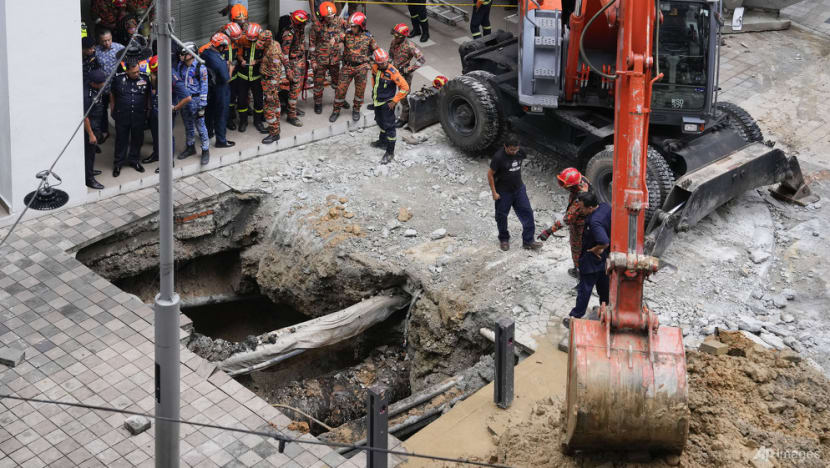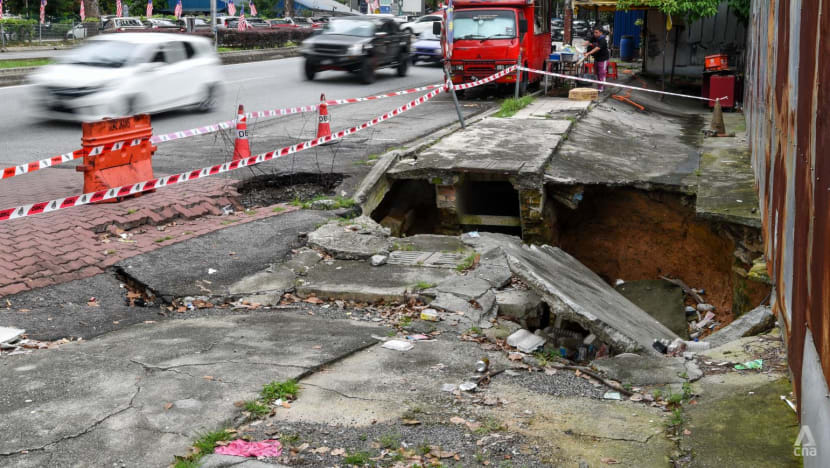CNA Explains: What could have caused the Kuala Lumpur sinkhole, and are there warning signs?
Sinkholes often happen very suddenly. But can they be avoided or at least minimised?

Malaysia's Fire and Rescue department use a crane to dig after receiving reports that a woman had fallen into a sinkhole after a section of the sidewalk caved in Kuala Lumpur, Friday, Aug 23, 2024. (Photo: AP/Vincent Thian)

This audio is generated by an AI tool.
SINGAPORE: A woman remains missing after falling into a sinkhole in Malaysian capital Kuala Lumpur last Friday (Aug 23).
This incident was followed by a caved-in drain on Tuesday, also in Kuala Lumpur, and another sinkhole opening up on Wednesday along the same stretch as the first.
What are sinkholes and how are they formed?
They are holes in the ground that come about when water dissolves surface rock, according to the National Geographic website.
That surface rock is often limestone, which is easily eroded or worn away by the movement of water.
In a landscape where limestone sits underneath the soil, water from rainfall can collect in cracks in the stone. And as the limestone dissolves and is carried away, the cracks widen until the ground above becomes unstable and collapses.
Sinkholes can vary from shallow ones about 1m down to pits more than 50m deep.
In an urban context, sinkholes can have man-made causes, said Ms Sharron Ng, a council member at the Institution of Engineers, Singapore (IES).
"Sinkholes (can) occur due to work activities such as over-pumping of the groundwater during underground construction work; broken pipes or sewers where leaking water can erode the soil beneath the surface; or mining activities where large voids may collapse."
Are there any warning signs?
Sinkhole collapses often happen very suddenly and without much warning.
There can be a visible sinking-in of the ground before a sinkhole occurs, but it's also possible that this doesn't show, said IES chairman of the civil and structural engineering technical committee David Ng.
That's when the ground is covered by a hard surface that could be suspended temporarily while a void is formed beneath it. When it suddenly gives way, the sinkhole occurs.
Other telltale signs include "movements or cracks of roads' architecture", said emeritus president of IES Singapore Chong Kee Sen.
What we know about the Kuala Lumpur incident
The 48-year-old woman, identified as Indian tourist Ms Vijayaletchumy, was walking on a pavement along the Jalan Masjid India road in Kuala Lumpur’s city centre.
She then fell into the 8m-deep sinkhole leaving behind only a pair of slippers.
The search and rescue operation involved inspections of manholes around the area as well as a treatment plant 7km away, where the sewer ends.

A few days later, a collapsed drain in a Kuala Lumpur suburb left a large hole along the Jalan Pantai Permai road.
Then another sinkhole opened up the next day, just 50m away from the one that swallowed Ms Vijayaletchumy.
Authorities have now closed off Jalan Masjid India entirely, and said they will conduct an “integrity audit” of the sewerage system along the road.

Does this mean Kuala Lumpur is unsafe?
The cause of the first sinkhole is still unknown.
While Kuala Lumpur’s geological formation is known for its widespread limestone bedrock, which is prone to dissolution, experts have told CNA this does not apply to all areas of the capital.
It still hasn't been established if the location of the incident was built on limestone.
On Sunday, Kuala Lumpur mayor Maimunah Mohd Sharif said the city “remains safe unless proven otherwise by studies”.
Any contrary claims must be backed by strong evidence, she said, as reported by the Bernama news agency.
A task force including the Department of Minerals and Geosciences, Kuala Lumpur City Hall, the Royal Malaysia Police and the Public Works Department has been set up to study the safety of development in the capital.
Nevertheless, Mr Ng from IES said the high levels of rainfall experienced by Kuala Lumpur could make the city more susceptible to sinkholes.
"The rainfall water may wash along with it the loose soil material in the ground and result in a void," he added.

Have there been sinkholes in Singapore?
They do occur occasionally in Singapore, said Mr Ng, and often due to construction activities and underground pipe leaks.
But he stressed that Singapore’s natural soil and geology are "not particularly susceptible" to sinkholes as geological conditions here do not have the characteristics of soluble rocks like limestone.
That's why sinkholes remain an uncommon occurrence in Singapore:
- In 2022, a sinkhole and some cracks were observed on a slip road at Farrer Road where tunnelling works were ongoing.
- In 2014, a section of Upper Changi Road East caved in, causing a tipper truck to collapse. This happened near a construction site for the Downtown train line.
- In 2013, a sinkhole appeared near a junction along Keppel Road and a driver steered his car into it.
- In 2013, a sinkhole about 2m wide appeared in the centre lane of Clementi Road towards West Coast Road. One motorcyclist claimed that he fell into it and suffered minor injuries.
Can future occurrences be minimised or prevented?
According to the website for Tensar Corporation, which provides ground stabilisation and soil reinforcement solutions, a study of geological maps can first identify areas susceptible to sinkhole formation.
But it cannot zero in on the specific location of a void.
Newer techniques to identify potential sinkholes include ground penetrating radar; low frequency and passive electromagnetic field technologies; and vibro-acoustics. But these require specialist "geotechnical expertise” to carry out and interpret the data.
Once a sinkhole is identified, the area around it can be excavated and filled with stable soil.
Alternatively, a grouting operation can be carried out, where a hollow steel casing is installed within and around the sinkhole to buffer the at-risk perimeter.
Then, the sinkhole is filled with a liquid mixture to stabilise the structure and prevent water infiltration.















